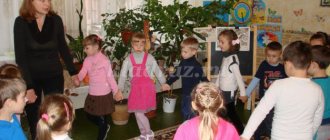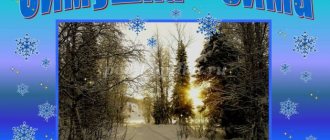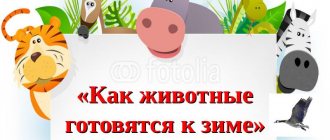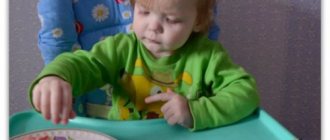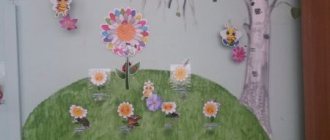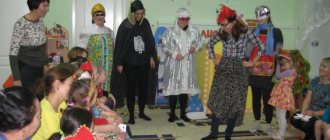Summary of educational activities for speech development for children of the senior group. How animals prepare for winter
GCD on speech development for children of senior preschool age “How animals prepare for winter”
Integration of educational areas: speech development, cognitive development, artistic and aesthetic development. Goal: Development of coherent speech in children. Objectives: - expanding children's knowledge about wild animals and how they prepare for winter;
— learn to correctly use diminutive suffixes and the use of plural nouns in speech; — development of creative abilities. Progress of GCD
I. Organizational moment 1. Breathing exercises. 2. Articulation gymnastics. 3. Learning pure saying: Rook. Ach-ach – black rook. Cha-cha-cha - we saw a rook. Chi-chi-chi - the rooks shout. Chi-chi-chi - rooks are walking across the field. Chkov-chkov-chkov - rooks are looking for worms. Whose-whose-whose - you won’t see rooks in the fall. II. Main part 1. Riddles about animals. Winter will come soon. This is a difficult time for the animals of the forest. Guys, let's talk to you about how animals spend the winter in the forest, where they sleep, and what they eat. But first, guess the riddle: In the summer he walks without a road near the pines and birches, and in the winter he sleeps in a den, hiding his nose from the frost. (Bear) All summer and autumn, the bear prepares for winter: he fishes in the river, eats a lot of berries, accumulates fat for the winter. At the end of autumn, the bear finds a place under a pine tree with a lot of leaves and branches, and in this place it goes to sleep until spring. And in winter, when a lot of snow falls, the bear will be warm in his den. What does a bear like to eat? (children's answers). The bear loves honey, berries, fish. In a dense forest under the fir trees, showered with leaves, lies a ball of needles, prickly and alive. (Hedgehog) Hedgehogs, just like bears, prepare for winter and accumulate fat during the summer and autumn so as not to get hungry and freeze in winter. They insulate their burrows. And when the first frosts begin, hedgehogs burrow deep into their burrows and fall asleep there for the whole winter. Guys, what does a hedgehog like to eat? (children's answers). That's right, guys, the hedgehog eats mice, frogs, and worms. The hedgehog also loves mushrooms and apples. White in winter, gray in summer. He doesn’t offend anyone, but he’s afraid of everyone. (Hare) Yes, it's a hare. Guys, how does a bunny prepare for winter? (children express their guesses). The hare changes his summer coat to a white one. The hare's winter coat is white, and its summer coat is gray. The hare's white coat is warm; it prevents him from freezing during frosts. Guys, do you know why a hare’s winter coat is white? (children's answers) The hare changes his gray coat to white so that he is not noticeable in the snow. Hares feed on tree bark and bush branches. What else does a hare like? (children's answers). The bunny loves carrots. A red-haired little animal jumps and gallops through the trees. He lives not on the ground, but on a tree in a hollow. (Squirrel) The squirrel is not afraid of winter. With the onset of winter, she, like a bunny, changes her fur coat, which helps her camouflage herself so that when she jumps through the trees, she is not noticeable. In summer, the squirrel wears a red coat, and by winter it turns gray. How does a squirrel prepare for winter? (children's answers). The squirrel collects berries, mushrooms, and nuts all summer and autumn and hides them in different places. The red-haired cheat hid under the tree. The cunning one is waiting for the hare. What is her name? ... (Fox) Prowls the forest day and night, Day and night looking for prey. Walks and wanders... silently, Gray ears stick up. (Wolf) How do fox and wolf prepare for winter? (children's answer). Their coat becomes warmer and they grow another, warmer fur. 2. Description of animals according to questions. - If a hare is afraid of everything, then what kind of hare is it? (cowardly). What else can you call it? (fast, careful). What is the hare doing? (jumps, hides, runs). — The fox is deceiving everyone. What is she like? (cunning). What is the fox doing? (sneaks, cheats). — A hedgehog has spines, what is it like? (barbed). What is the hedgehog doing? (snorts, carries mushrooms on thorns). - What kind of squirrel? (fast, agile). What does a squirrel do? (jumps, stores nuts, cones, mushrooms). - What kind of bear? (clubfooted, strong, clumsy). What is the bear doing? (waddles around, roars, sleeps). 3. Game “Find the babies their mothers.” The teacher shows pictures of young wild animals and asks them to find their mothers among the other pictures, putting the pictures in pairs: - fox - fox cub; - she-wolf - wolf cub; - hare - little bunny; - she-bear - little bear; - hedgehog - hedgehog; - squirrel - baby squirrel. 4. Game “One - many”. Children call cubs in the plural. - little hare - little hares; - little fox - fox cubs; - wolf cub - wolf cubs; - bear cub - bear cubs; - baby squirrel - baby squirrels; - hedgehog - hedgehog. 5. Creation of a collective work “How animals prepare for winter.” Children are offered colored pencils and sheets of paper to depict any animals and how they prepare for winter. Then each drawing is cut out and glued onto whatman paper depicting an autumn forest.
We recommend watching:
Summary of a subgroup GCD on speech development in the senior group. Summary of a lesson on speech development in the senior group. My Sevastopol Speech therapy lesson in a senior group on the topic: Autumn Summary of a lesson on speech development in a senior group with a presentation. Bazhov "Silver Hoof"
Similar articles:
Summary of a lesson on speech development in the senior group. Retelling of a work of art. Tolstoy "Two Comrades"
Summary of a lesson in the senior group on an autumn theme based on the fairy tale “Apple” by V. Suteev
Summary of a lesson in the senior group on the topic “Harvest, vegetables, fruits”
How does a squirrel prepare for winter?
Many people assume that squirrels hibernate because they are rarely seen during the winter. However, it is not. Instead of hibernating, they actually spend most of their time sleeping in hollow trees and only come out in the morning and evening.
Squirrels prepare for winter by collecting acorns, nuts, berries, mushrooms and even tree bark and storing it all in shallow holes next to trees or in their nests. They also increase food intake, thereby increasing body weight.
In winter, squirrels survive by eating stored food and maintaining a constant body temperature. They are also called homeotherms, meaning that they are warm-blooded animals that can maintain a stable body temperature over a wide range of environmental conditions by regulating the metabolic processes of heat production and loss. This act of regulating their temperature is a way of achieving balance in the body.
To monitor temperature levels, sensors in the blood vessels constantly transmit information about body temperature back to the hypothalamus in the brain. Squirrels maintain a stable body temperature (within homeostasis) by sleeping together. This is a form of thermal conduction in which heat can be transferred between two proteins in contact. Squirrels are also endotherms, meaning they can create their own heat through metabolism. This explains why squirrels maximize their food intake in preparation for winter. When it's very cold in winter, squirrels also use shivering to stay warm as it's a way of generating heat.
